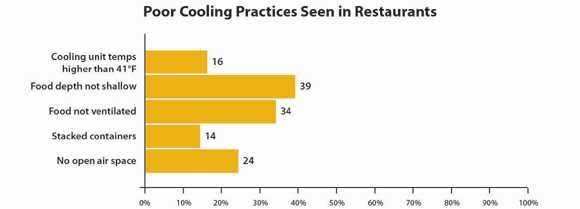How Restaurants Cool Food
This page shows the study purpose, method, results, conclusions, and recommendations in plain language for the EHS-Net project titled Restaurant Food Cooling Practices Study.
The findings and recommendations from this project are also in fact sheet format [PDF - 182 KB].
Citations for more EHS-Net publications are available by Study Topic or by Citation.
Study Problem
Hot food needs to be cooled quickly to stop germ growth and foodborne illness outbreaks caused by germs. From 1998 to 2008, hot food cooled too slowly led to 504 outbreaks of foodborne illness in restaurants. We don’t know much about how restaurants cool food. If we learn more, we can improve how restaurants cool food. And we can lower the number of foodborne illness outbreaks.
The U.S. Food and Drug Administration (FDA) Food Code includes advice on how to cool food safely and quickly. This advice includes cooling food
- In the refrigerator at or below 41°F,
- In shallow pans, and
- In a way that air can flow around and in the pans (ventilated). Food can be ventilated by
- Keeping it loosely covered.
- Not stacking pans of cooling food on top of each other.
- Providing open air space around pans of cooling food.
FDA’s advice also focuses on using processes tested and proven to cool food safely.
Study Purpose
The purpose of this study was to describe how restaurants cool food and whether they follow FDA advice.
Study Findings in Brief
EHS-Net found many restaurants did not follow FDA’s cooling advice:
- Temperatures in cooling units were above 41° 16% of the time.
- Hot food was not put in shallow pans more than a third of the time.
- Hot food was not ventilated about a third of the time.
- Many restaurant cooling processes were not tested and proven.
Study Method
Participants
We gathered data from 420 restaurants in the 2009 EHS-Net sites. We chose these restaurants at random.
Data Collection
State or local environmental health specialists gathered the data. In each restaurant, the specialists talked to a manager and watched how food was cooled.
Study Results
Cooling practices
Some restaurants did not follow FDA advice on cooling:
- 16% of cooling unit temperatures were above 41°F.
- Shallow* pans were not used more than a third of the time.
- Food was not always ventilated.
- Food was not loosely covered almost a third of the time.
- Pans of cooling food were stacked on top of each other 16% of the time.
- There was no open air space around pans of cooling food a fourth of the time.
*For this study, “shallow” was defined as 3 inches or less.
Cooling processes
Most managers said that their cooling processes did not follow all of FDA’s advice. Their processes
- Were not tested and proven more than a third of the time.
- Did not include keeping track of food cooling time and temperature more than a third of the time.
- Did not include checking to see if thermometers were working well about 16% of the time.
Study Conclusions
Many restaurants do not follow FDA cooling advice. These restaurants have cooling problems they need to address.

EHS-Net Recommends
Restaurant managers and food safety programs should work to improve restaurant cooling practices. These efforts should focus on
- Improving poor cooling practices and processes, as found in this study.
- Tackling barriers to proper cooling.
Key Terms
- Environmental health specialists: public health workers who enforce health and safety standards related to food and other consumer products.
- Food Code: A guide developed by the FDA on how to store, prepare, and cook food safely. Most state local rules and laws about food safety are based on the Food Code.
- Foodborne illness: an illness caused by germs in food.
- Foodborne illness outbreak: when two or more people have the same sickness after eating food from the same place.
- Ventilated: a way that air can flow around and in pans of cooling food (e.g., loosely covered or uncovered, pans not stacked, space around the pans).
- Page last reviewed: March 28, 2013
- Page last updated: August 16, 2016
- Content source:


 ShareCompartir
ShareCompartir